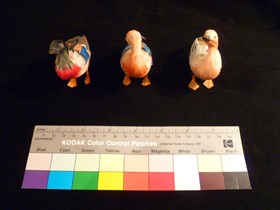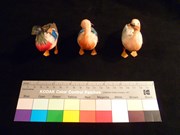Narrow Results By
Duck Toy, Animal
https://archives.whyte.org/en/permalink/artifact108.05.1030%20a-c
- Date
- n.d.
- Material
- feather; metal; paper; paint
- Catalogue Number
- 108.05.1030 a-c
- Description
- 3 miniature ducks all distinguished by different coloured feathers and various poses. The variety in intensity of the colourful plumage from one bird to the next suggests the symbolism of one single bird going through the transformation brought on by the moulting process. (a)This duck exhibit the …
1 image
- Title
- Duck Toy, Animal
- Date
- n.d.
- Material
- feather; metal; paper; paint
- Dimensions
- (a)7.0; (b)6.7; (c) 7.8 x (a)3.8; (b)3.8; (c)3.8 x (a)7.5; (b) 7.0; (c)7.3 cm
- Description
- 3 miniature ducks all distinguished by different coloured feathers and various poses. The variety in intensity of the colourful plumage from one bird to the next suggests the symbolism of one single bird going through the transformation brought on by the moulting process. (a)This duck exhibit the most vibrant and colourful feathers and is posed with its head looking forward. The eyes of the duck have been attached separately and are light pink with a black speck for the pupil. The beak of the duck has been carved to give fine details like the mouth and nostrils. The underlying colour of the bird’s body is a light pink colour. The black coloured head turns to deep green when working down the long neckline onto the breast or chest at which the feathers change dramatically from deep green-to-red. The primary wing feathers on the back are blue with white and black detailing. If the wings were open the remaining body would be light black with a white tip at the tail. The underside of the body, or the bum, is green. The webbed feet are orange and appeared to be fashioned from wire and paper machete. In the middle of the back there is a knotted string. (b)This duck has been posed with its head back toward the viewer left side. The eyes of the duck have been attached separately and are light pink with a black speck for the pupil. The beak of the duck has been carved to give fine details like the mouth and nostrils. The underlying colour of the bird’s body is a light pink colour with more of this colour being revealed throughout the entirety of its body. The muted pink coloured head turns to a rusty orange colour when working down the long neckline onto the breast or chest where this muted pink colour dominates. The primary wing feathers on the back are very similar to the previous duck, however the blue tone is far more turquoise with white and black detailing. If the wings were open more of the pink-tones would be revealed, which spans even onto the tip of the tail. The underside, or bum, also shows the rusty-orange and pink hues that are consistent throughout the remainder of the duck’s body. The webbed feet are orange and appeared to be fashioned from wire and paper machete. In the middle of the back there is a knotted string. (c)This duck has the least amount of colour present and is posed with its neck slightly back in a somewhat awkward position. The eyes of the duck have been attached separately and are light pink with a black speck for the pupil. The beak of the duck has been carved to give fine details like the mouth and nostrils. There is very little colour contrast throughout the duck’s body. Light pink, white, light brown and gray hues dominate the body.
- Credit
- Gift of Nicholas Morant, Banff, 2006
- Catalogue Number
- 108.05.1030 a-c
Images
This material is presented as originally created; it may contain outdated cultural descriptions and
potentially offensive content.
Read more.


